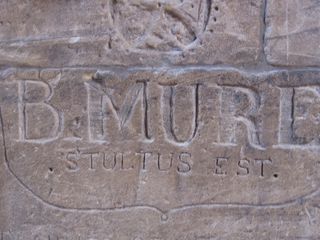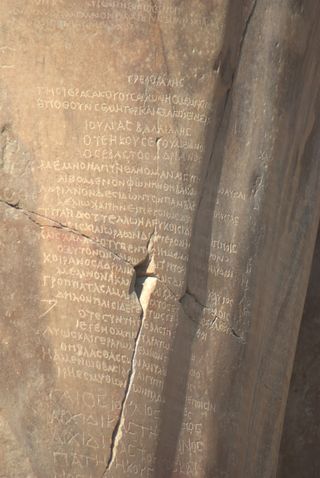Mary Beard's Blog, page 70
January 25, 2011
Cairo riots: eye witness account
I dont usually use this blog for other people's words. But I have just had an email from the son in Cairo, who has seen and been in today's demonstrations. This is some of what he has to say:
"What follows is my personal and not very well informed view on the situation. The only benefit I have is that I have just returned from the protests so can at least offer my view as a Briton living in Cairo. I can never be quite part of the protest. People tell themselves that this is because it is the Egyptians' struggle but also, in my case, it is due in small part to fear. Getting arrested in Egypt is something almost all foreigners are afraid of and being deported would do nothing good for my Arabic studies.
I woke up late and was not particularly interested in the protests since all Egyptians I had spoken to said that nothing would ever happen. However, one of my friends said that they were going to Cairo University because Facebook had told them that was the place to go. We went on the Metro but found that there was very little going on. Apparently, the venue had been changed to surprise the police and we had not been informed. Someone said that the Egyptian government had shut down Facebook, which was not in fact the case to my knowledge, but there are rumours that they will and Twitter is out for the foreseeable future (sorry mum!).
Nothing happened at Cairo University and the French seemed disappointed there would be no '68 style occupations. We decided to go back to Tahrir square (Cairo's main hub), where we live and saw hordes of security in the morning but only an eerie silence in place of any protest. On the way back in a taxi we found our protest. The police had blocked them from crossing the bridge from one side of the river on to an island in the river that would eventually lead to Tahrir Square.
It also blocked our return home so we were in the protest whether we liked it or not. We got to the next bridge to find more riot police. The number of police at the government's disposal is simply astonishing; there are talks of similar protests all over Cairo and the rest of Egypt. Without boring you with the details we made it back to Tahrir Square to see protest in full force. We went to get shisha and consider our next move. At the café we were later met by a friend who had just been tear-gassed and said that things were hotting up.
We went back and decided to go for our evening stroll around Tahrir, but without all the annoying traffic, it was an old fashioned sit in, and seemed like it could have been in the UK (without the copious marijuana consumption). There are huge numbers of people there, mostly chanting and just sitting out. We ran into a nice schoolboy who couldn't stay the night because he had a French exam the next day. There was also an eccentric old gentleman shouting anti-governmental slogans (Down with Mubarak, Egypt will be free, etc.) mixed with pro-Nasser ones. The protesters are certainly very brave, numerous times there were people running to back up their friends in battles with the police as I was skulking away.
Perhaps it is due to my cowardice but I have seen few examples of police brutality (unless you count tear-gas). I have seen people sporting injuries and bloody faces, even a man with a riot helmet, but no cast-iron evidence of police beatings. They seem to rely mostly on their fiercesome reputation and enormous man power to keep control.
What is going to happen now is just as unpredictable as the protests themselves. At the moment it is non-violent but things could easily change. What is certainly sure is that people are preparing to stay the night. When I was picking up my dinner I was in a 30 minute queue behind the policemen doing the dinner-run, so they certainly expect a late one. Maybe after today the protests will just die down, maybe not. However, the Egyptian government has the added bonus of being a staunch western ally, and defence against Islamic extremism.
The Muslim Brotherhood has not officially supported the protest but they are appealing to similar economic concerns that were at least part of the reasoning for the protests. One imagines there are many in the West very concerned about the Muslim Brotherhood taking power. The US, earlier on today, were reported as saying that the Egyptian government remains strong in the face of these protests. Perhaps this will be a decisive obstacle for the Egyptian Protesters. It is hard for experts, let alone me, to predict; perhaps everything will simply fizzle out or perhaps not but for now I can still hear chants and sporadic tear-gas canisters going off above What It's Worth by Buffalo Springfield from my stereo (sorry for the cliché)."
Can't do better than that.
PS: an update from the son in his apartment near Tahrir Square:
"The police have began unrelenting volleys of tear gas from Tahrir Square.
Concerted effort to get people out of the square. Pretty powerful stuff.
Still chanting but who knows when they'll use more than tear gas. Feels like
revolution"
January 24, 2011
The advantages of knowing Latin
Before we visited the temple of Philae (one of those moved and re-erected after the new Aswan dam), we spotted some interesting stuff in the Rough Guide. One of the bits of graffiti, it said, was written by a Roman -- because it was in Latin: "B Mure stultus est", "B Mure is stupid".
Hang on we thought. What kind of Roman name is B Mure. Either someone had copied the name down wrong, or sure as hell the graffiti wasnt Roman.
As you can see, the latter was the right answer. First B Mure had come along and scratched his name...then some Latin-ate nineteenth-century tourist, follower or enemy had come along later and written 'stultus est'... the Latin equivalent of 'B Mure is an idiot'.
So who was B Mure. Our guess is that it was Benoit Jules Mure (1809-1858) a "pioneer of homeopathy", who in the nineteenth century took homeopathy to Malta, Sicily and Brazil, before coming to Egypt and Sudan with his new medical science. If he went from Egypt to Sudan, then Philae would have been on his route.
So maybe the Latin graffiti-artist was a dissatisfied patient....rubbishing homeopathy as much as the practitioner.
Anyway, without any clue about Latin and Roman names, you'd be taken in by the Rough Guide. A small victory (ok, only a small one) for Latin. But it so happened that when I was in Egypt I was reading a book on portraiture . . . a good one, but it could likewise have done with a bit more Latin.
It was Shearer West's Portraiture (OUP) -- and highly recommended in general. But it starts with a portrait by Holbein of George Gisze, with an inscription on the back wall, or actually a piece of paper pinned up. West says a bit vaguely that it is written in a mixture of Greek and Latin and that it translates "The countenance which you perceive is an accurate image of Gisze".
None of this quite added up, and it wasnt much helped by the slightly garbled Latin text printed in the end-notes.
A hard look, and blowing up the picture on the laptop, showed for a start that it wasnt a mixture of Greek and Latin. The poem was headed "DISTICHON in imaginem Georgii Gysenii" (that is, "a two-liner on the painting of George G" .. though Holbein also seems to have garbled the Greek pretty badly. It then goes on, not to say that it is an accurate image, but "sic oculos vivos sic habet ille genas": literally "he has living eyes just like this, and cheeks"..(unless you think that "vivos" is for "vivus".. the "living man has..."). It ends with George's age (34) and the date.
Well OK maybe that does come down, more or less, to "accurate". But this is a book about portraiture for heaven's sake, and one of the things at issue is what is "lifelike" about a portrait, and which bits carry that verisimilitude. And that's what Holbein was going on about. It's kind of important.
Getting the Latin right would have helped.
January 21, 2011
Death on the Nile

We ended up seeing many of the sites of Upper Egypt from a cruise boat. I can't say that I had ever imagined that I would find myself on a Nile Cruise . . . but the husband and son agreed that we should give it a go, if only for the Agatha Christie experience.
The fact is that Nile cruising is not quite what it was. Because of security restrictions, you can no longer get on the boat at Cairo and chugg along to Aswan; you can only travel from Luxor to Aswan. It doesn't take long to realise that it is actually faintly silly to take four days to travel on a boat a distance you could drive in not much more than three hours. (Unlike a sea cruise, you do most of the 'sailing' in waking hours to maximise the illusion of distance.)
That said, there were some very good sides to the whole thing. We had picked on a boat called the Philae (owned by the Oberoi hotel chain), partly because it looked romantic and partly because every room has a balcony onto the river (why go on a Nile cruise if you cant gawp at the river whenever you  want to?). We had also splashed out on a bigger room, which turned out to be well worth it, as there was bags of space to swing a cat or two.
want to?). We had also splashed out on a bigger room, which turned out to be well worth it, as there was bags of space to swing a cat or two.
 The views were stupendous (I thought that I was immune to that kind of thing...
The views were stupendous (I thought that I was immune to that kind of thing...
but I kept burbling all the time about how stunningly beautiful it all was) and the food a treat (Oberoi is an Indian chain and the curries were to die for . . . and the chef was so proud of his kitchen that he let you wander round it). As for cultural experiences, the high point was not a great monument of Egyptian antiquity, but going through the Nile lock at Essna where, in an engaging variant  of squeezy merchants at traffic lights, a host of little rowing boats crowded around us throwing up all sorts of merchandise for inspection and possible purchase. In the transaction, half of the stuff fell into the river (most of it in plastic bags... and most of it, but not all was rescued). Was this private enterprise? Or a nice side show organised by the Oberoi, I found myself wondering?
of squeezy merchants at traffic lights, a host of little rowing boats crowded around us throwing up all sorts of merchandise for inspection and possible purchase. In the transaction, half of the stuff fell into the river (most of it in plastic bags... and most of it, but not all was rescued). Was this private enterprise? Or a nice side show organised by the Oberoi, I found myself wondering?
All the same I am not wholly sure that I am quite cut out to be a passenger on a cruise boat.

For a start you have to surrender yourself to the whole enterprise and just let yourself be taken over and organised. That could be OK, but our particular guide was not a safe pair of hands. To be fair he tried very hard, and our group cant have been an easy assignment for any one. But the incessant stream of half truths (at best) about Egyptian culture was enough to send you screaming for another gin and tonic (of which there were many on the boat). The son was the most charitable in observing that we were witnessing the failures of the Egyptian education system. If so, it is something like the Greek education system, writ large . . everything started in Egypt (which was the USA of the ancient world); ancient Egyptian religion offered a unique form of spirituality, which was inherited by Christianity (Isis being a forerunner of the Virgin Mary). The Ptolemies and the Romans didnt get much of a look in, despite the  fact that almost every monument we visited was largely post-Pharaonic (like the pic of the Roman emperor making his offering on the right). In fact our guide was very wobbly even about the date of the Romans.
fact that almost every monument we visited was largely post-Pharaonic (like the pic of the Roman emperor making his offering on the right). In fact our guide was very wobbly even about the date of the Romans.
There is sociality to be surrendered to as well. The sticking point for us was the 'Galibaya party' on the penultimate night. I'm never a great fan of fancy dress. But the idea of a group of well heeled Brits (and others) travelling in style through an ex-piece of colonial territory, and then dressing up as ex-colonial "natives" was really too much to take. It reeks too much of Prince Harry's birthday. (Unless, of course, you think of it as the final revenge of the colonised on the colonisers.)
On this occasion we needn't have worried too much. About half the boat were refuseniks (including all the middle aged academics ... of which there were quite a few).
January 18, 2011
This isn't Caligula's tomb

The news this morning is full of the "discovery" of the emperor Caligula's tomb at Nemi, by the lake about 30 kilometres out of Rome. The details are pretty murky. The police apparently arrested a guy who was loading a statue of the monster young emperor into the back of a lorry.
I havent seen a picture of this yet. But how do we know it was Caligula? Because, they say, it was wearing the 'caligae" or sandals that gave the emperor his nickname (his 'real' name was Gaius). Errr? Aren't there loads of Roman statues that wear these?
And why do we think that it marked his tomb?
Simple. Because it makes a good story that gets a load of press coverage for the discovery made by these no doubt brave policemen (the illicit antiquities business is probably second only to drug running in its nastiness).
All the evidence we have from the ancient world suggests that this cannot be so.
Caligula was assassinated in his palace on the Palatine Hill in Rome in 41 AD. According to Suetonius' Life (chap 59), his body was taken to the horti Lamiani, the site of an imperial pleasure gardens on the Esquiline Hill. There he was quickly cremated and buried a light covering of turf. Later on his sisters returned, to cremate and bury it properly.
There is no suggestion whatsoever, so far as I know, that this burial was at Nemi, or that it was a grand tomb (the Latin just says "buried", sepultum). True, Caligula had a big villa there, but it is almost inconceivable that this assassinated symbol of imperial monstrosity would have been given a grand monument, plus a big statue there.
Besides there is no evidence for that whatsoever.
Much more likely is that he had a modest burial in or near the horti Lamiani, or -- as some people think -- that he was slipped into the big Mausoleum of Augustus (where many of the imperial family ended up).
January 16, 2011
The tomb of Tut -- what does Zahi Hawass intend to do?
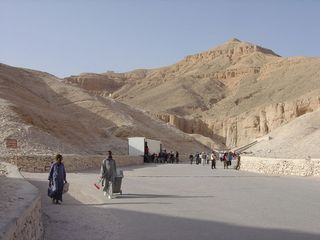
Apologies to those with other interests; but this blog has had a brief splurge into Egyptology, thanks almost entirely to my Egyptian trip.
But not quite entirely. Today's Sunday Times carries a story that has been going around for some months - that the Egyptian Archaeological Service intends to ban visitors from the Tomb of King Tut, and eventually from all the tombs in the Valley of the Kings, and to get us non-egyptologists visiting a series of clever replicas, rebuilt near the one-time house of Howard Carter. And so they hope to 'save' the monuments themselves.
I had vaguely noticed reports of these schemes before, but I paid more attention today as I had just visited the Tomb of Tut.
Two things to start with. First, there is obviously a big problem in the Valley of the Kings. If you have 60 odd tombs that for more than 3000 years were intended to be shut off from human contact, and you open them to widespread (though hardly "mass") tourism, you have a problem. Tourist sweat certainly erodes painting.
Secondly, I have never been much of an admirer of Zahi Hawass, the current supremo of Egyptian Antiquities . . . a master archaeological showman to be sure, but it is not yet clear how much more than that he is. It is apparently his brainchild to close off as many of the "real" tombs as possible to ordinary visitors. And it is certainly not clear how confident we should be in his proud claims to "know best". "I'm the guardian, I know what is good for their preservation" he is quoted as saying.
May be that's true. But we have, of course, heard that before -- from generations of expert, well meaning, highly-qualified conservationists charged with looking after the world's heritage. And as many disasters as successes have been the result.
I cannot quite work out the details of the Hawass scheme. But the particular arguments that the Sunday Times quotes really don't add up. He claims that the frescoes of the paintings are being ruined by flash photography. In fact, there is already a rigorous policy of banning cameras entirely from the Valley of the Kings: you have to leave them at the entrance to the whole site, and unusually for Egypt, this ban seems to be enforced. Over two hours last week, I saw not a single person using a camera there, flash or no flash.
He also claims that the tombs are inundated with people. Well, they are not -- for one simple reason. The Archaeological Service has already imposed the so-called 'plastic bouncer' on the big tombs on the site. It now cost 100 Egyptian pounds to visit the tomb of Tut (that is about £10-12 per head). When we were there, at about 9.00 a.m. on a big tourist day, we met perhaps 5 or 6 other people there over a perios of 10-15 minutes (it would be hard to spend longer in the tomb itself, there aint anything to see).
Quite what bit of Egyptian archaeological politics lies behind all this, I do not know, But it looks, from the outside, like much the same issue as Pompeii and Herculaneum, or Stonehenge for that matter. What exactly are we preserving these monuments FOR? Do we expect them to survive thousands, indeed millions of visitors intact? Should we be palming the average visitor off with a replica?
I can't be the only archaeological professional (well, in my case, semi-professional) who thinks that the "replica solution" for the average tourist is deeply patronising. Sure, if there is archaeological information still to be extracted, then maybe we should protect these sites from the uninitiated. But it Tut's case, there is surely nothing more to be got. Perhaps it is better to let the currently exposed monuments gracefully disintegrate, while leaving what is still undergraound remain there. (Not the current Egptian policy: the mayor of Luxor is, as I write, busy demolishing villages to excavate yet more tombs, to be as big a conservation problem as they will be a tourist draw.)
I found myself wondering whether (contrary to the Hawass scheme) we should be letting the public in free, and building an expensive replica for the archaeologists?
January 15, 2011
The face of Paris -- and Cleopatra
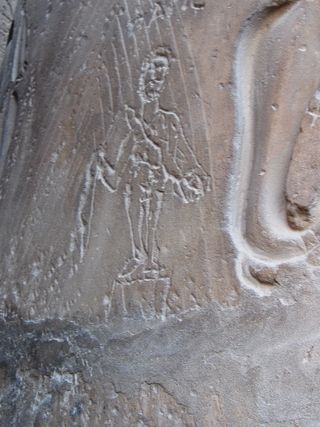
The next bit of graffiti we have been chasing is the rather rough and ready image of Paris at the head of this post. It is scratched on a column in one of the main halls of the Egyptian Temple at Luxor. It is headed "Paris", though you can only just see a trace of this at the very top. And, so far as we can tell,it shows a statue (at least it's on a base) of the Trojan (anti-)hero, holding an apple in one hand and a quiver in the other.
We were looking for this in the temple (though -- fair dues -- it was the son who actually found it). One idea, according to some article I read, is that this is a Greco-Roman graffiti, which represents the famous lost statue of Paris by Euphranor. But, more than that, so the same article claims, it is also a reflection of the idea, made famous in Euripides' play Helen, that Helen of Troy did not actually go to Troy at all, but only an image of her (an eidolon).
How come? Well, this graffito has been scratched right next to a statue of Nefertari. So here, the 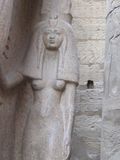
argument goes, the Roman scratcher has seen an image which he has interpreted as the eidolon of Helen and depicted Paris next to it.
It was the husband who pointed out that this doesn't quite add up. But something quite close to it does.
For starters, on the Euripidean version it was Helen who went to Egypt and the eidolon that went to Troy -- so logically this statue of Nefertari can't have been re-interpreted as the eidolon (it's the wrong place). The husband must be right to say that the graffiti artist saw the Egyptian statue (naked) as an image of Aphrodite.. which is why, as in the judgement of Paris, the graffiti figure is holding an apple in his hand, all ready to award it to the Goddess of Love. Still, it is a nice Roman re-interpretation of an Egyptian image, but probably no connection with Euripides.
Next stop after Luxor has been the Temple of Denderah, where you can find wonderful images of Roman emperors all represented as if they were pharaohs from hundreds of years before (whether this is Roman imperialism trying to cash in on the prestige of pharaonic power, or the Egyptian priests trying to incorporate the emperors into their own version of the world, is anyone's guess). But round the back  ofthe temple is one of the most 'authentic' images of Cleopatra VII to have survived ... as an Egyptian queen, plus her little boy Caesarion (not in this picture). In the Roman version of history this child was the son of Julius Caesar (or maybe he wasn't.. but Cleopatra claimed him as such); at Denderah he too appears as a little pharaoh.
ofthe temple is one of the most 'authentic' images of Cleopatra VII to have survived ... as an Egyptian queen, plus her little boy Caesarion (not in this picture). In the Roman version of history this child was the son of Julius Caesar (or maybe he wasn't.. but Cleopatra claimed him as such); at Denderah he too appears as a little pharaoh.
Whatever complexity underlies all this, it is salutary to remember that some of the best bits of "Egyptian" art are actually creations of the Ptolemaic and Roman periods (just as much of what you see of ancient Greece is actually Roman in date).
*****
As a postscript, we have just visited the Temple of Edfu -- another of these Ptolemaic/Roman constructions. There we saw some of the clearest artistic interfaces between traditional Egyptian and 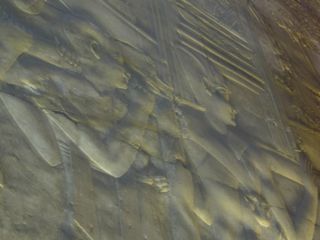 Greco-Roman art, but in the other way direction. It's not a good picture I'm afraid, but hese carriers of the sacred bark (?) seem at first sight much like all the other Egyptian images of this scene -- but a closer look at the way they are depicted, at the modeling of the faces and the flesh suggests that this was either a Ptolemaic trained sculptor, or someone who had studied Ptolemaic work.
Greco-Roman art, but in the other way direction. It's not a good picture I'm afraid, but hese carriers of the sacred bark (?) seem at first sight much like all the other Egyptian images of this scene -- but a closer look at the way they are depicted, at the modeling of the faces and the flesh suggests that this was either a Ptolemaic trained sculptor, or someone who had studied Ptolemaic work.
January 12, 2011
The Colossi of Memnon? When are graffiti not graffiti?
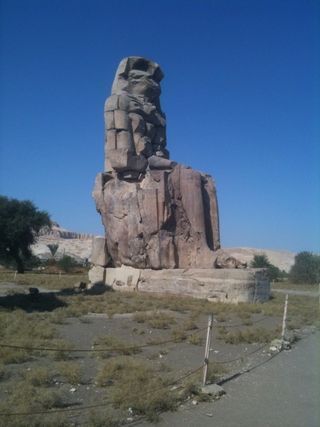
I have wanted to see the Colossi of Memnon for ages. These are two huge statues of the Pharaoh Amenhotep III which have stood since the fourteenth century BC outside the remains of his "mortuary temple" not far from Luxor in Southern Egypt. It isn't their Egyptological history that interests me particularly (in fact even after a few days in Egypt, I'm just as bad as I ever was at telling my Nefertaris from my Nefertitis . . . or my Amenhoteps from my Akhenatens; and indeed I have been known to glaze over when having them explained).
For me these statues are important because they were a Roman tourist attraction -- and it is fun to be gawping at monuments that Germanicus or Hadrian gawped at a couple of thousand years ago. Not exactly for the same reasons, it must be allowed. One of the colossi was especially renowned in the early Roman empire because, thanks to some damage (possibly in an earthquake in the first century BC), the effect of the stone warming up in the morning made the statue emit a strange sound like singing. It the Romans said that it was not Amenhotep at all, but an image of the hero Memnon, son of Dawn...who miraculously sang to greet his mother each morning. Or, he sang most mornings; there were some unlucky visitors who didn,t hear the singing.
The Romans loved the sound and also finished it off. The statue was repaired in the second century and never sang again.
Predictably perhaps, the tourist guides here (who have never heard of Memnon) tell a brave new version of the story... that they were believed to be statues of AGAmemnon who wept at dawn. In such ways new myths are born.
Anyway, I had long known that the upmarket Roman visitors did not just admire the sound, they scratched their appreciation in the stone of the figure's huge leg. There are some notable verses, for example, by a lady in Hadrian's party (Julia Balbilla) recording her appreciation in several lines of vaguely Sapphic verses. (These are all published in a full publication by A and E Bernand.)
I have always called these 'graffiti' before. But a visit has shown that that is quite the wrong way of looking at them. For a start, Julia Balbilla could hardly have improvised her careful Sapphic lines when she arrived and heard the statue perform. She almost certainly came with them already up her sleeve (nothing spontaneous here). But just looking at the texts all over the statue's leg suggested that these texts were a very professional operation. They were mostly very neat (not an amateur scrawl at all, and must have taken a good day to complete even for a trained inscriber); and several of them, even allowing for the changing ground level, were so high up that you would require more than a chair to stand on.. something more like a mini-scaffolding.
This was not graffiti in the usual sense of the term at all. It was public display writing commissioned by a set of high ranking Romans, writing themselves onto a famous, semi-mythical Egyptian monument (or alternatively an attempt by the locals to commemorate visits by famous foreign dignitories).
It was funny that we then went onto the temple at Luxor (much of which was also built by Amenhotep III) and saw graffiti of a different sort there... also of a "more than meets the eye" kind. The guide book was very keen on the signature of (Arthur) Rimbaud, the poet and gun-runner, very high up on the wall of one of the furthest chambers ... indicating how much higher the ground level was in the 1880s at the time of Rimbaud's visit.
What the guide book didn't say was that there was another Rimbaud signature on another column a few feet away. This aroused a bit of suspicion. Did Rimbaud ever actually go to Luxor? Well so far as I can tell from web-research, he was certainly in Egypt, but only known in the north. Enid Starkie (who appears to have believed that Luxor is near Alexandria) knew of no other evidence than his 'signature' on the temple.
We have ended up with the distinct impression that once Byron had started the tradition of poets carving their signatures into ancient temples, that was not only an encouragement for any old poet to do the same -- it was an encouragement for any fan to FORGE the name of their favourite poet onto an appropriately grand antiquity.
Or does someone have some clear, independent evidence that Rimbaud did make it as far as Luxor?
January 9, 2011
A day in Cairo

I was extremely grateful for the suggestions from all of you about what we should do in Cairo, but I have to confess that the one full day we had here was given up to pleasure more than intellectual improvement (though that came in its usual back door route). This wasn't so reprehensible, as I have been to Cairo a few times before -- and have been pretty energetic in the Archaeological Museum, the Old City (with Dr Alcock's guide). etc.
This time, given we had just a day, I was in the end keener to suss out what the son was doing, the style of student life in Cairo. He is learning Arabic in a serious way there, like I always intended (and no, I haven't actually got further than the most basic restaurant-speak).
So we wandered through the streets of Garden City, near our hotel, past the British Embassy (which looks like a bunker..), around the antique shops (full of fakes? or real nineteenth century French furniture? or nineeteenth century Egyptian copies of French furniture? or modern Egyptian copies of nineteenth century French furniture - - - I couldnt honestly tell),and the cake shops (the calories that Islamic culture saves in alcohol, it makes up for in sweeties) until we got to the son's flat on the eighth floor of an old(ish) block downtown.
like a bunker..), around the antique shops (full of fakes? or real nineteenth century French furniture? or nineeteenth century Egyptian copies of French furniture? or modern Egyptian copies of nineteenth century French furniture - - - I couldnt honestly tell),and the cake shops (the calories that Islamic culture saves in alcohol, it makes up for in sweeties) until we got to the son's flat on the eighth floor of an old(ish) block downtown.
I am pleased to say that he and his mates have followed local tradition and bought a couple of budgies, at about 3 quid a head (seen in the picture at the top -- and don't worry they do get plenty of time out of their cage, swooping round the flat).

It was in fact a lot better than I had expected, though the view from the balcony is simultaneously charming in its urban squalor and depressing in its poverty. I'm not sure if you can see on the picture, but there are tents and makeshift huts on the flat roofs of the surrounding buildings -- where people are indeed living.
And -- nice as our hotel is -- it does raise all the questions about this kind of tourism and where the  money that it raises goes. The son pointed out that the hotel car we had booked from the airport cost more than what the (comparatively well paid) domestic staff at his university own per month. Just the car journey alone . . . never mind the room (with a fantastic view over the Nile, and onto the pyramids in the distance), the dinner and the round of pre-prandial cocktails.
money that it raises goes. The son pointed out that the hotel car we had booked from the airport cost more than what the (comparatively well paid) domestic staff at his university own per month. Just the car journey alone . . . never mind the room (with a fantastic view over the Nile, and onto the pyramids in the distance), the dinner and the round of pre-prandial cocktails.
But of course that's what nice western liberal tourists always worry about...while still going on spending their money in the same way.
January 7, 2011
To tweet, or not to tweet?

I have just signed up to a Twitter account. Many people (including some commenters) had urged me in this direction. But, in the end, the reason I took the plunge was very simple. Fiona Maddocks had given me a bit of much needed support on Twitter in the face of AA Gill and his "how could someone from Newnham understand a willy?" line. (Let him come to Newnham, I say...There's an invitation, Mr Gill!). I couldn't find her email address to say thanks, so I signed up to Twitter to do it that way.
Soon enough I found had some good friends "following" me.
So what now?
I haven't quite manged to tweet ever since. That's partly because I haven't worked out how to do it from my phone.
But it's partly because I haven't worked out what to say. The world might be interested in whether S. Fry is at that minute intending to drop by Starbucks, but sure as anything they are not remotely interested in M Beard's coffee drinking habits.
I have speculated on a more academic approach... "just read a great article on the Quindecimviri Sacris Faciundis in Zeitschrift fur Papyrologie und Epigraphik", but wasn't sure how that would go down. I am tempted by the "message from the front line of the lecture" -- which Charlotte Higgins has done very nicely... "here I am sitting in Nottingham and Prof X has just said that the Romans didnt cut their toe-nails". But I havent been to any lectures lately.
So what? I am shortly to decamp from Cairo (posting on this soon) to some Roman sites in Egypt (still on the hunt for images of Roman emperor). If you would like to give me some suggestions, on what to tweet and how to do it, I will try my best.
January 5, 2011
Mr Willetts, soft A levels and the "pool"
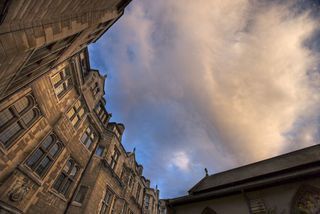
I spent a few hours before leaving for Egypt (burglars, forget it, there are still some family living in the house), in the Cambridge Admissions Pool. It is an unfortunate nickname, maybe. But a very good thing. All the details of candidates to individual colleges, who did not make it at their first choice college but were thought worthy of a place at Cambridge, are available in this "pool" (which is, in fact, the Newnham dining hall, stuffed full of files and reports and references). Representatives of all colleges with places still to fill are there, looking for good students. In most subjects (mine included) there are also meetings of all the Directors of Studies and Admissions Tutors in the different colleges to make sure that as many of these students are accepted as possible.
I know how ghastly it is to get one of those letters saying that you application was very good, but that there was no place at your college of choice. But, let me assure you, that there have been hundreds (literally) of academics in the Pool these last few days looking to find good students for the remaining places, scrutinising the applications, reading the references -- and all those statistics about the average exam results for the school in question, the number who go to university etc . The truth is that we want to take as many people as we can -- we dont want to reject the good. Dont believe what the papers tell you about how cavalierly or unfairly we take the admissions process.
But meanwhile, if he has been correctly reported, Mr Willetts has been pontificating.
His idea is that we (that is principally Oxbridge and other Russell Group universities) should be publishing the A levels that we don't take seriously. Indeed he is going to make us, it's said. It is unfair that students should be tempted to study A level subjects (like Citizenship or Sports Studies) that might detract from their application to "good" universities .. who are much keener on History and Further Maths.They need to know before they make their choices.
Well OK. But actually this is another of those bright ideas which we thought the coalition might have transcended.
For a start Cambridge does already give teachers and potential students advice, on its website, about their choice of A Level subject. We do it positively, not negatively -- that is we suggest what a sensible range of subjects might be, rather than blacklisting some. There are several reasons for this. For a start, just imagine the furore there would be if we said, in effect, "Dance" was not an A level we recognised. But more to the point, at the very top of the ability range, it is very hard to lay down fixed rules. I would certainly not want to say that I would never want to take someone with A levels in Dance, Media Studies, German and Classical Civilisation. The point about our individual admissions system is that we look at individual qualifications on a case by case basis. There are guidelines, but not (many) rules.
But, even more important, kids normally make their A level choices long before they have any clue whether they are going to aim at Oxbridge (or another "good" university) -- in fact before they have even got their GCSE results. Apart from a handful of swots, only a very few 15-16 year olds are, on their own, likely to decide on their sixth-form choices by reference to some list of less favourable A levels.
The people who can give them the best advice are their teachers who know them.
Ironically, the now standard transition between 11-16 school and sixth-form college makes the force of this advice more difficult to deliver. My experience with my own kids of touring the local sixth form colleges is that it is a subject auction. They go to an open evening to find Media Studies competing with Russian (well, we'd be so lucky) or Biology for student enrolment. And there is only limited advice on sensible combinations, and still less advice at this stage which might take informed account of the potential career trajectory of these students.
Nonetheless it is teachers who are the best qualified to deliver advice, and on whom the responsibility for this must lie. And from where do the teachers get the information? Well, actually, very many teachers are very good at this already. But in addition the University and most Cambridge colleges offer all kinds of personalised advice on this subject to both pupils and teachers. Mine certainly does. You just need to email or call,
I know we are supposed to be off-putting etc etc. But if we offer help, you might at least give us the benefit of the doubt and trust that this advice is sincerely and freely given. We really dont need to publish a Willetts list of "banned" A levels.
Mary Beard's Blog
- Mary Beard's profile
- 4076 followers



